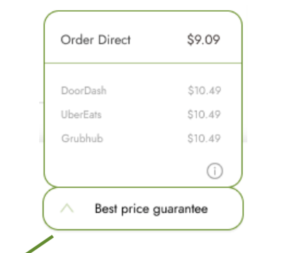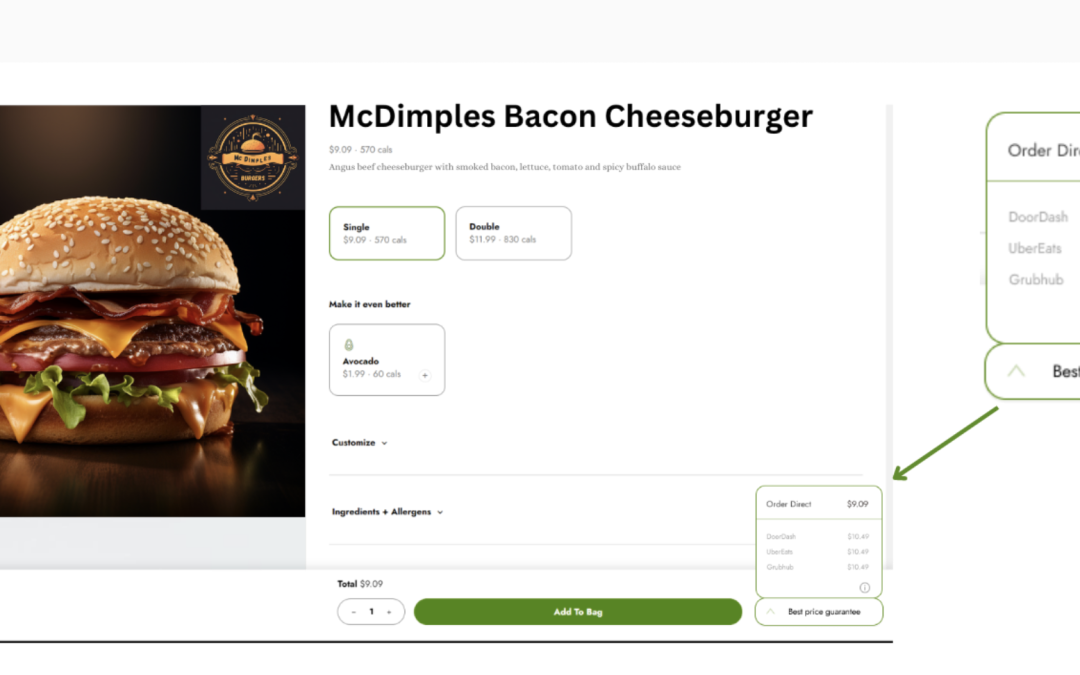Juicer, a San Francisco-based company that helps brands implement dynamic pricing, has launched a new product that aims to help restaurants drive direct orders.
“Enlighten” is a consumer-facing widget for restaurant websites that highlights the cost-savings consumers can experience when ordering direct versus third-party delivery.
How it works: A customer orders as they normally would through a restaurant’s website. Before checking out, the widget will pop up and compare prices between ordering directly on the website versus whichever third-party platform the restaurant may be integrated with such as DoorDash or Uber Eats.

‘Enlighten’ is a consumer-facing widget for restaurant websites that highlights the cost-savings consumers can experience when ordering direct versus third-party delivery.
The idea was born at the Food On Demand Conference in May, during a lunch where Juicer founder and CEO Ashwin Kamlani listened to restaurant brands voice their frustration about their inability to convert third-party customers into direct-ordering customers.
The rise of third-party delivery platforms has certainly added complexity when it comes to running a successful restaurant. Gaining that valuable visibility on third-party marketplaces and access to delivery fleets is essential, yet that comes hand-in-hand with added commission fees that have proved troublesome for many. On the consumer side, there are also cost savings and loyalty opportunities when ordering direct.
In his discussion with restaurant brands, Kamlani noted how a majority aim to showcase the savings consumers could receive by ordering directly, by including paper-based messages inserted into third-party delivery orders. “But it seems, generally, people do not look at them and in large franchises, it’s quite impossible to scale that activity and have it done consistently,” he said.
Restauranteurs also expressed to Kamlani their frustrations surrounding the recent announcements from DoorDash and its requests for price parity—calling on restaurants to not hike up their pricing on delivery menus compared to dining-in menus, a move many operators use to offset third-party fees.
Thus, Enlighten came to fruition. In development of the widget, Kamlani reflected on his years in the hospitality industry.
“I was thinking to myself that, in the hotel industry, there is a solution to this, and that same tension exists between hotels and third-party distribution channels like Expedia and booking.com. So, what a lot of hotels did was implement a widget on their website that reinforced for their consumers that they were saving money, by booking direct.”
Kamlani adds that he recognizes this shift in consumer behavior in the hotel industry did not happen overnight.
“But the consumer did learn over time, oh, I’m better off shopping on Expedia, but once I’ve decided what I want, then I should go directly to the airline or directly to the hotel website because I’m going to save money and might get better benefits or points,” he explained.
However, as the majority of consumers still order through third parties like DoorDash, Juicer aims to get the word out by offering the Enlighten technology at “very low cost” according to the company.

Juicer CEO and co-founder Ashwin Kamlani
Restaurant groups with a minimum of 20 locations can receive Enlighten at a “deep discount” if the contract is signed by September 30, 2023. Juicer states the implementation of the widget is “extremely simple” and can be dropped easily into any restaurant’s website, with colors that match their restaurant’s branding.
Juicer anticipates growth
Meanwhile, on the pricing side of things, Kamlani relays it is still taking time for restaurants to jump on the dynamic pricing bandwagon, which helps them determine when and what items to raise prices on to boost profitability during peak periods, or even lower prices when business is slow to spur traffic.
“There’s a general consensus in the industry that this is needed and that this is going to happen and there’s no doubt whether it’s a good idea,” said Kamlani “But restaurants groups are overwhelmed” and “it’s not in the top two or three main issues that restaurants are looking to solve in the next few quarters.”
Kamlani adds there is still skepticism surrounding how consumers react to dynamic pricing. As the macroeconomic environment has changed and consumers are tightening their belts, he says Juicer’s latest approach is to help consumers figure out what the optimal promotion and offers are on “which products, at which times and which channels.”
“Then we’re going to help you measure the effectiveness of those promotions, so that’s the direction the solution is going,” he added.
But momentum at Juicer continues to build, the company says they have ramped up sales activity and are expecting to close “at least eight to 10 deals in August and September with larger groups than we have been working with now,” said Kamlani.
“We have made it our mission to become profitable by Q1 2024, and we are well on track to reach that goal. That’s going to allow us to become self-sufficient and focused on what we do best, which is help create more data-driven solutions for the restaurant industry to optimize ecommerce sales.”


